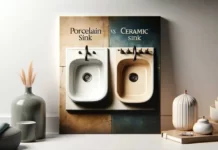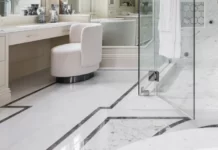Considering what the washroom goes through each day, you probably want to clean them every day using the best cleaners. Despite it, they can develop certain problems that are difficult to remove. For instance, consider molds, a type of fungus that can sprout up in your washroom. Molds are not the most attractive elements that you witness in your washrooms and other places around the house.
Unfortunately, they are highly common in your households, especially in the showers. The main reason is that they populate and thrive in moist and warm environments. They tend to quickly spread around if left unchecked or are fed throughout, which means that your spotless clean washrooms would now be covered with black mold all around. Before you even know it, they tend to glue themselves to the grout and start to spread out as they grow.
Upon reading this, you may have queries rushing through your mind like, how to remove mold from caulk? Or how to get rid of black mold in shower caulk? Or maybe how to remove mold from silicone caulk?
Well, put aside your worries, as we bring forth this guide to you, as we teach you how to clean moldy caulk from your showers. This will indirectly help you in preventing its future growth. Before we discuss how to remove mold, let us discuss something important.
Is Mold Dangerous?
For the most part, mold is relatively harmless. It is just irritating and gives off a bad impression to anyone using the bathroom. Nevertheless, mold can cause worsened asthma and other allergies. Thus, we recommend that you work on removing it right away. You might not realize it, but the mold can quickly spread to other parts of the house. In such cases, you might need professional help, which is costly and certainly not what you want.
How to remove mold from under silicone caulk?
If you wish to remove mold from underneath your silicone caulking, then the ideal technique would be to completely replace your current one. Yes, this means you need to get your hands on a fresh set of caulking material. You must be wondering, why not simply clean the caulk? Well, as easy as this may sound, there are high chances that it may grow back. Hence, to completely eliminate the root cause, it is best to remove it.
Additionally, make sure that there are no damp sources that can lead to the formation of mold in your caulking.
People who find this method a bit harder can opt for a second option – cleaning the mold from your silicone caulking. However, this option comes with its own limitations like taking into consideration the growth and the size of the mold. Yes, you can only opt for this method if your mold growth or size is in a limited quantity and has not spread all around. An approximate length would be around 5 or even 6 inches, although you may need to closely monitor it and check for its recurrence.
In case, when it revisits, you will have to completely remove it and replace it with a new one.
While you replace your old caulk, make sure you check for brands in the market that provide a mold-resistant caulk material; since they comprise chemicals that are able to eliminate mold growth. However, if you do not feel comfortable or confident performing this task all on your own, then you can always hire a professional to do it for you.
How to remove mold from shower caulking – Tips & Tricks
Bright, clean shower caulk and grout can make your bathroom look spotless, but getting rid of mold takes a special action plan. The challenge: mold and mildew thrive in a warm, moist environment – like your shower!
Removing molds from your shower caulk is a challenging task, especially since they have the most appropriate conditions available to grow and spread. If you are assuming that scrubbing can get your job done, then you would be disappointed to find out that it would not make it go away. You need to kill it for its complete removal.
Listed below are a few tips and tricks on how to get rid of mold in shower caulk.
1. Gather the Required Tools
You need to get yourself tools like a cleaning soft brush, a spare toothbrush, a sponge for scrubbing, a dustpan, and a hand vacuum or a broomstick. You can easily find such products at your local store. We recommend that you keep a separate tool set for the shower mold. Why? It is best to avoid using the same products elsewhere.
2. Dust Removal
Sweep clean or vacuum any debris or dust that is present on the shower-tiled bathroom floor. This precaution is important as it prevents the spreading of any mud or dirt on your caulk and the cleaning solution as you use a spray.
3. Mix it Up
You need to create a bleach mixing solution in a spray bottle. Use the ratio of 10 water parts with one bleach component. There are several products that are made specifically for shower mold. You can opt for them. Some of them might be too expensive as compared to the bleach solution. Nevertheless, all types of products will do a good job. So, do not think too much about it.
4. Spraying is Essential
Spot the mold on the caulk and spray the solution all over, making sure it covers all the mold spots and is thoroughly soaked in it. We recommend that you pay extra attention to this step. Most people ignore it. They just spray the solution without making sure that it is spread all over the mold. Later, they complain that the solution does not work. Hence, make sure that all the mold is properly soaked before moving onto the next step.
5. Waiting Time
Allow the mixed solution to set for approximately 5-10 minutes of time. You should wait longer if the mold has been around for a long time. Why? Mold which is quite old is stuck onto the surface. Hence, it can be difficult to remove it. You should leave the solution on for about 20 minutes. Now, move to the next step.
6. Scrub it Off
Use a toothbrush or scrubbing sponge to scrub off the mold growth. Make sure that you put real effort into it. If you are too gentle, it will be impossible to remove the mold. Therefore, make sure that you use considerable force while scrubbing.
7. Rinse it Thoroughly
Use a clean rag or a wet cloth to wipe off your newly cleaned caulk.
8. Use Vinegar
Many people fail to understand the importance of vinegar. To make sure that you are not cleaning the mold again in a couple of months, use vinegar. Spray it onto the mold and let it rest there for a few hours. Once done, warm a pitcher of water. Then, pour the warm water over the vinegar. Now, 10 times out of 10, the mold is non-existent.
That’s it. After the last step, the mold is gone. If not, we recommend that you repeat the process. If that does not work, it is time to ask for professional help. There are several professional cleaners out there that can remove the shower mold without any difficulty. They might be a little expensive, but they will get the job done without a hitch.
You can use the same process as above for places other than your bathroom. Remember, proper ventilation can prevent mold build-up in the first place. Therefore, make sure that the bathroom has adequate ventilation and keep the doors open too. While using the cleaners, please protect your hands and face. You do not want your skin to come into contact with these cleaners. Otherwise, you might end up doing severe damage to your skin.
FAQs
How does mold grow on shower caulking?
Mold grows in moist and humid areas, and shower caulking provides an ideal environment for mold to thrive. If the caulking is not properly maintained and clean, mold can grow on it.
Why is it important to remove mold from shower caulking?
Mold can cause health problems and make your bathroom look unsightly. Additionally, if left unchecked, mold can spread and damage other parts of your bathroom.
Can I use vinegar to remove mold from shower caulking?
Yes, vinegar is a natural and effective mold remover. To remove moldy caulk, combine equal amounts of white vinegar and water in a spray bottle. Let it sit for at least 30 minutes before scrubbing with a brush.
Is bleach the best solution for removing mold from shower caulking?
Bleach is a potent mold remover but it can harm your health and can also damage your caulking if used excessively. Make sure to use it in moderation and thoroughly rinse the area after use.
What are some natural remedies for removing mold from shower caulking?
There are a few other natural mold removal options besides vinegar, such as tea tree oil, hydrogen peroxide, and baking soda. Mix them with water and apply them to the moldy caulk before scrubbing with a brush.
How often should I clean my shower caulking to prevent mold growth?
In order to avoid mold growth, you should clean your shower caulking at least once a month. However, if you notice mold growth, it’s essential to address the issue immediately.
All in All
This concludes our article. We request that you re-read it to make sure that you have not skipped out on any vital part. Not many steps or efforts are involved in removing shower caulk mold. In fact, it is quite an easy process if you use tools like chemical bleach and other cleaners. We are hopeful that you must now be aware of how to remove mold from shower caulking without facing much trouble. It is time to implement these techniques in your bathrooms!













